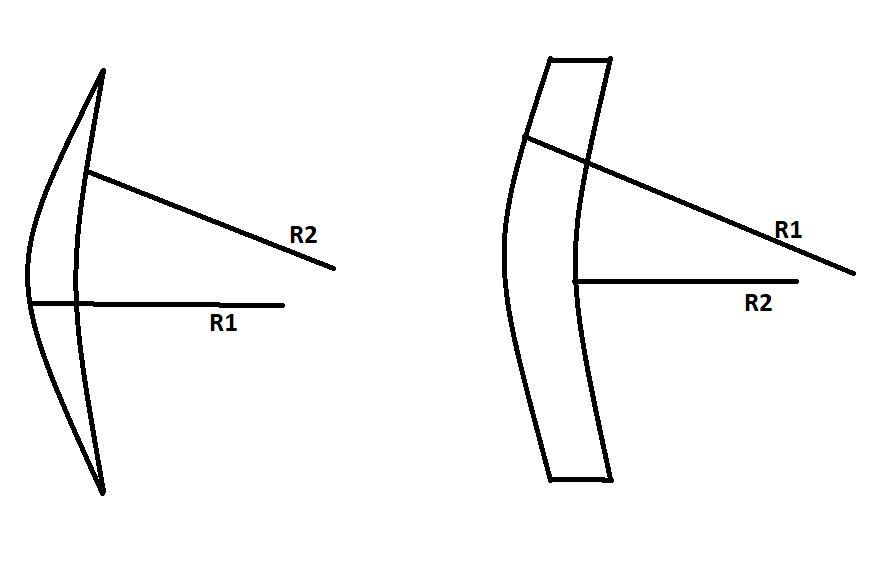
A lens that has convex surface at one side and concave surface at another side behaves as :
a) convergent lens when the radius of curvature of convex surface is greater than that of concave surface.
b) divergent lens when the radius of curvature of concave surface is greater than that of convex surface.
c) convergent lens when the radius of curvature of convex surface is less than that of concave.
d) divergent lens when the radius of curvature of concave surface is less than that of convex surface.
A.)a,b are true.
B.)a,d are true.
C.)c,d are true.
D.)b,c are true.
Answer
581.1k+ views
Hint: We will first draw the diagram of the lens in two cases, that is one side concave one side convex, then write the radius of curvature formula and compare that with the radius of curvature of both the sides and if that is greater than zero then the focal length is positive and the lens acts as a converging lens, and if it is less than zero then focal length is negative and lens acts as a diverging lens.
Complete step by step answer:

Here in the above, we see two lens drawn according to the question,
We know, that the radius of curvature of R$_{1}$ and R$_{2}$ of the surface is represented by,
$\dfrac{1}{f}=(\mu -1)(\dfrac{1}{{{R}_{1}}}-\dfrac{1}{{{R}_{2}}})$ , here f is the focus, new is the refractive index .
We are considering the medium as air, so $\mu -1>0$
When radius of curvature of concave surface is more than the radius of curvature of convex surface as shown in the first diagram (the diagram on the left) then,
$\dfrac{1}{{{R}_{1}}}-\dfrac{1}{{{R}_{2}}}>0$,
From this we can conclude that the focal length of the lens will be positive and the lens will act as a converging lens.
When radius of curvature of convex surface is more than the radius of curvature of concave surface as shown in the second diagram (the diagram on the right) then,
$\dfrac{1}{{{R}_{1}}}-\dfrac{1}{{{R}_{2}}}<0$
From this we can conclude that the focal length of the lens will be negative and the lens will act as a diverging lens.
Hence, Option D is the correct option.
Note: Remember as no medium is given we can consider any medium in which we are comfortable, it is not compulsory to choose the medium as air, there are two cases when the radius of curvature convex surface is more than that concave surface, and the radius of curvature concave surface is more than the convex surface. In the first case lens focal length is always negative and the lens is considered a diverging lens, and in the second case just the opposite happens that its focal length is always positive and the type of lens is converging.
Complete step by step answer:

Here in the above, we see two lens drawn according to the question,
We know, that the radius of curvature of R$_{1}$ and R$_{2}$ of the surface is represented by,
$\dfrac{1}{f}=(\mu -1)(\dfrac{1}{{{R}_{1}}}-\dfrac{1}{{{R}_{2}}})$ , here f is the focus, new is the refractive index .
We are considering the medium as air, so $\mu -1>0$
When radius of curvature of concave surface is more than the radius of curvature of convex surface as shown in the first diagram (the diagram on the left) then,
$\dfrac{1}{{{R}_{1}}}-\dfrac{1}{{{R}_{2}}}>0$,
From this we can conclude that the focal length of the lens will be positive and the lens will act as a converging lens.
When radius of curvature of convex surface is more than the radius of curvature of concave surface as shown in the second diagram (the diagram on the right) then,
$\dfrac{1}{{{R}_{1}}}-\dfrac{1}{{{R}_{2}}}<0$
From this we can conclude that the focal length of the lens will be negative and the lens will act as a diverging lens.
Hence, Option D is the correct option.
Note: Remember as no medium is given we can consider any medium in which we are comfortable, it is not compulsory to choose the medium as air, there are two cases when the radius of curvature convex surface is more than that concave surface, and the radius of curvature concave surface is more than the convex surface. In the first case lens focal length is always negative and the lens is considered a diverging lens, and in the second case just the opposite happens that its focal length is always positive and the type of lens is converging.
Recently Updated Pages
Basicity of sulphurous acid and sulphuric acid are

Master Class 12 Business Studies: Engaging Questions & Answers for Success

Master Class 12 Economics: Engaging Questions & Answers for Success

Master Class 12 English: Engaging Questions & Answers for Success

Master Class 12 Maths: Engaging Questions & Answers for Success

Master Class 12 Social Science: Engaging Questions & Answers for Success

Trending doubts
Differentiate between homogeneous and heterogeneous class 12 chemistry CBSE

When was the first election held in India a 194748 class 12 sst CBSE

December 10th of 1948 is an important day in the history class 12 sst CBSE

Prove that a parallelogram circumscribing a circle-class-12-maths-CBSE

The computer jargonwwww stands for Aworld wide web class 12 physics CBSE

What is the Full Form of PVC, PET, HDPE, LDPE, PP and PS ?




